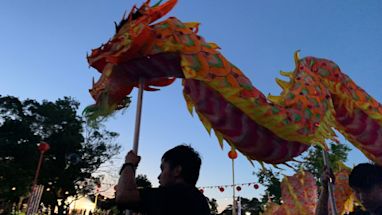This article is part of a series by Aboriginal and Torres Strait Islander peoples living and working on Gadigal land. The series, a joint project of South Sydney Herald and the City of Sydney, is curated by Wiradjuri woman Aunty Norma Ingram.
I’m Aunty Joyce Wymarra from Badu, one of the western islands of the Torres Strait.
I was born on Badu Island and lived there until I was 8 years old. We did a lot of fishing and gardening of sweet potatoes, casava and coconuts. We also dug for pippies, oysters and cockle shells. We got the shells to make necklaces and wove the coconut shells and leaves and reeds to make hats and grass skirts, fans and mats. We wore the skirts and sat on the mats when we did our dancing, singing and ceremonies.
I still speak my western island language fluently. Language is the main part of our culture and it is so important for us to keep speaking our language.
As young children we sat with our grandmothers and watched how they made these things. We were then able to make things ourselves. We didn’t always get it right at first but we kept trying and learning with our grandparents.
We were able to put our designs on the mats but they had to be designs with traditional meaning. Now we can put special colours. With our dances we always have a drum and shakers.

We have different languages in the Torres Strait Island and some different dialects. There are only 18 letters in our alphabet. I couldn’t speak English until I went to Thursday Island coloured school. We were punished if we spoke our language. Our people were separated and had curfews on the islands.
My husband and I moved to Sydney in 1973 with our 4 children. We lived in the western suburbs and then moved to Woolloomooloo where we had 2 more children. My children went to Plunkett Street Primary School.
We still have our Torres Strait Islander culture in Sydney.
The men blow the bull shell to bring the people together for ceremonies and meetings. When our people pass away, the people sit for days to mourn their passing. The family is looked after and fed by the in-laws. After 5 years, we put a headstone and then we do the unveiling to complete the mourning period.
Today I live in Glebe. I believe that our Torres Strait Islander culture is important in the inner city. Our culture, along with the Aboriginal culture, is taught in our local school. Sometimes I get invited to the schools and talk about our culture to the children. We speak western and eastern Torres Strait Islander languages. We still do the dances and songs in our important dresses. We are able to explain about the stories, songs and dances.
This article originally appeared in South Sydney Herald.
Learn more about Aboriginal culture and history at the Sydney Barani website.
Published 18 December 2023



